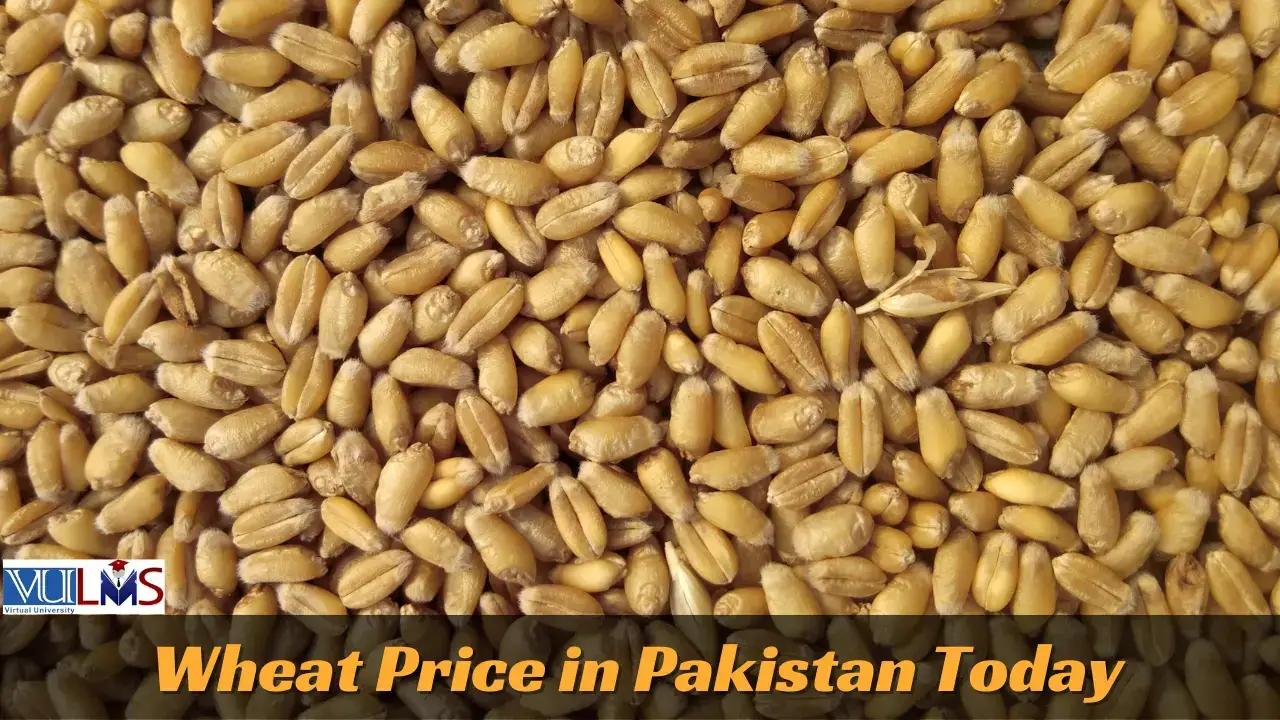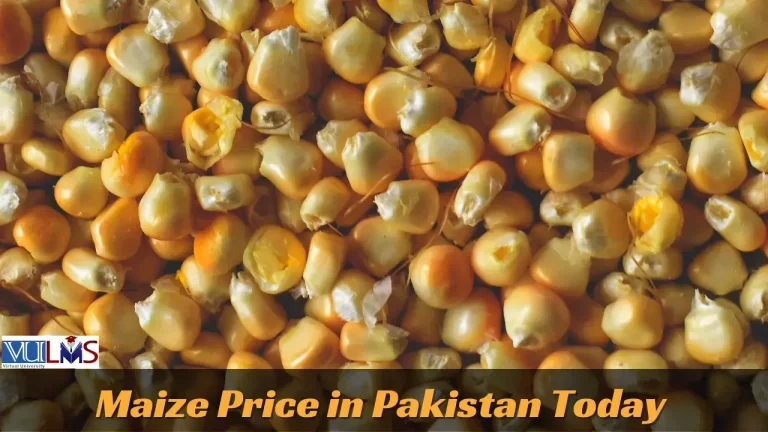Wheat Price In Pakistan Today | Gandum Rate per 40 KG 2024
Have you ever found yourself pondering over the enigmatic fluctuations of wheat prices in Pakistan? Today we embark on a journey to unravel the complex world of wheat price in Pakistan, with a particular focus on the rates for 40 KG of gandum in 2024. This seemingly humble grain holds immense importance, touching the lives of every Pakistani, and it is crucial to understand how it affects our daily existence.
Wheat Price in Pakistan today, often ranging between Rs. 3200 to Rs. 3850 per 40 KG, is not just a figure; it represents the economic livelihood of countless farmers, the dietary choices of families, and the stability of the nation’s food supply. In this article, we’ll peel back the layers of this multifaceted topic to shed light on the factors, trends, and impacts that shape the wheat price landscape in Pakistan. Join us on this exploration as we delve into the past, present, and future of wheat prices, attempting to make sense of the perplexing wheat price puzzle.

Today Wheat Price In Pakistan ( Gandum Rate )-آج گندم کی قیمت
Today’s wheat price in Pakistan, known as “Gandum Rate,” fluctuates within a range of approximately 3200 PKR to 3850 PKR per 40 KG. These variations not only reflect the dynamics of supply and demand but also hold significant implications for the country’s agriculture and economy. For farmers, the wheat price is a pivotal factor in determining their income and economic stability. Consequently, the wheat price in Pakistan stands at the crossroads of agricultural prosperity and food security, affecting the lives of millions across the nation.
Wheat Price/Rate In Punjab
Punjab, the agricultural heartland of Pakistan, plays a pivotal role in the nation’s wheat production. Wheat prices in Punjab not only influence the livelihoods of countless farmers but also have broader implications for the country’s food security.
| District / City | New Wheat Minimum Rate | New Wheat Maximum Rate |
|---|---|---|
| Khanewal | 3,500 PKR | 3,830 PKR |
| Fazil Pur | 3,200 PKR | 3,300 PKR |
| Haroonabad | 3,300 PKR | 3,370 PKR |
| Mianwali | 3,300 PKR | 3,700 PKR |
| Chowk Azam | 3,350 PKR | 3,600 PKR |
| Rawalpindi | 3,400 PKR | 3,500 PKR |
| Lahore | 3,600 PKR | 3,850 PKR |
| Lodhran | 3,500 PKR | 3,750 PKR |
| Yazman Mandi | 3,270 PKR | 3,330 PKR |
| Rajanpur | 3,200 PKR | 3,350 PKR |
| Toba Tek Singh | 3,270 PKR | 3,340 PKR |
| Muzaffargarh | 3,500 PKR | 3,800 PKR |
| Bhakkar | 3,400 PKR | 3,700 PKR |
| Khanpur | 3,270 PKR | 3,350 PKR |
| Dera Ismail Khan | 3,500 PKR | 3,700 PKR |
| Islamabad | 3,420 PKR | 3,500 PKR |
| Vehari | 3,200 PKR | 3,300 PKR |
| Fortabbas | 3,200 PKR | 3,350 PKR |
| Chishtian | 3,300 PKR | 3,300 PKR |
| Chowk Munda | 3,380 PKR | 3,560 PKR |
| Dunga Bunga | 3,300 PKR | 3,400 PKR |
| Maroot | 3,200 PKR | 3,330 PKR |
| Layyah | 3,250 PKR | 3,320 PKR |
| ArifWala | 3,200 PKR | 3,550 PKR |
| Faisalabad | 3,300 PKR | 3,600 PKR |
| Faqirwali | 3,300 PKR | 3,560 PKR |
| Ali Pur | 3,400 PKR | 3,500 PKR |
| Chakwal | 3,350 PKR | 3,550 PKR |
| Sadiqabad | 3,200 PKR | 3,390 PKR |
| Gujranwala | 3,600 PKR | 3,700 PKR |
| Hasilpur | 3,200 PKR | 3,280 PKR |
| Multan | 3,500 PKR | 3,800 PKR |
| Okara | 3,300 PKR | 3,700 PKR |
| Chakwal | 3,350 PKR | 3,600 PKR |
| Pattoki | 3,500 PKR | 3,700 PKR |
| Sheikhupura | 3,500 PKR | 3,800 PKR |
| Pakpattan Sharif | 3,350 PKR | 3,400 PKR |
| Bahawalnagar | 3,300 PKR | 3,420 PKR |
| Bahawalpur | 3,450 PKR | 3,600 PKR |
| Chichawatni | 3,200 PKR | 3,390 PKR |
| ArifWala | 3,200 PKR | 3,550 PKR |
| Sargodha | 3,600 PKR | 3,750 PKR |
| Dera Ghazi Khan | 3,300 PKR | 3,400 PKR |
| AhmadPur Sharqia | 3,200 PKR | 3,280 PKR |
| Mian Channu | 3,450 PKR | 3,500 PKR |
| Chowk Azam | 3,350 PKR | 3,600 PKR |
| Mian Channu | 3,450 PKR | 3,500 PKR |
| Chakwal | 3,350 PKR | 3,550 PKR |
Wheat Price/Rate In Sindh
Sindh, with its unique agroecological conditions, contributes significantly to wheat cultivation in Pakistan. The wheat prices in Sindh reflect the regional variations and dynamics that can significantly impact the choices of both farmers and consumers. Examining the factors that shape these prices in Sindh is key to grasping the complexity of wheat markets in the country.
| District / City | Minimum Rate | Maximum Rate |
|---|---|---|
| Tando Allah Yar | 3,400 PKR | 3,450 PKR |
| Sanghar | 3,560 PKR | 3,710 PKR |
| Dadu | 3,320 PKR | 3,400 PKR |
| Shikarpur | 3,460 PKR | 3,520 PKR |
| Sukkur | 3,620 PKR | 3,700 PKR |
| Tando Muhammad Khan | 3,480 PKR | 3,500 PKR |
| Mehrabpur | 3,500 PKR | 3,630 PKR |
| Hyderabad | 3,400 PKR | 3,500 PKR |
| Mirpur Khas | 3,520 PKR | 3,540 PKR |
| ShahdadPur | 3,450 PKR | 3,500 PKR |
| Ghotki | 3,380 PKR | 3,440 PKR |
| Kunri | 3,350 PKR | 3,400 PKR |
| Nawab Shah | 3,400 PKR | 3,500 PKR |
| Umarkot | 3,450 PKR | 3,500 PKR |
| Larkana | 3,420 PKR | 3,520 PKR |
| Jhuddo | 3,450 PKR | 3,520 PKR |
| Sakrand | 3,520 PKR | 3,680 PKR |
| Karachi | 3,500 PKR | 3,600 PKR |
Wheat Rate/Price In Balochistan
Balochistan, Pakistan’s largest province, faces its own set of challenges and opportunities in wheat cultivation. Wheat rates in Balochistan are closely tied to local agricultural practices and environmental factors. Delving into the intricacies of wheat pricing in Balochistan provides insights into how this diverse region contributes to the nation’s wheat production.
| District / City | Minimum Rate | Maximum Rate |
|---|---|---|
| Balochistan | ||
| Sibi | 3,475 PKR | 3,580 PKR |
| Quetta | 3,675 PKR | 3,780 PKR |
Wheat Rate/Price In (KPK)
Khyber Pakhtunkhwa (KPK) is another significant wheat-producing region in Pakistan. The wheat rate in KPK is a critical factor for the economic well-being of farmers and the availability of wheat-based products for consumers. Understanding the factors affecting wheat prices in KPK helps us comprehend the regional dynamics that shape Pakistan’s wheat landscape.
| District / City | Minimum Rate | Maximum Rate |
|---|---|---|
| KPK | ||
| Dera Ismail Khan | 3,500 PKR | 4,000 PKR |
| Mardan | 3,450 PKR | 4,000 PKR |
Also Read:
Sugar Rate in Pakistan Today | 1 KG Cheeni Price
Analyzing Price Fluctuations
The fluctuating nature of wheat prices in Pakistan is a puzzle that perplexes many. In this section, we will delve into the various aspects of price fluctuations and dissect the factors that contribute to this complex phenomenon.
Causes of Price Fluctuations
Understanding why wheat prices in Pakistan are subject to frequent ups and downs requires a multifaceted perspective. Several key factors contribute to these fluctuations:
- Supply and Demand Dynamics: The most fundamental force driving price changes is the interaction between supply and demand. When wheat production surpasses consumption, prices tend to decrease, and when demand outpaces supply, prices rise. Factors such as weather conditions, crop diseases, and planting decisions can disrupt the supply-demand equilibrium.
- Global Market Influences: Pakistan is not isolated from the global wheat market. International factors, such as changes in wheat prices in major exporting countries, trade policies, and global supply disruptions, can have a ripple effect on local prices.
- Government Policies and Interventions: Government policies, subsidies, and interventions also play a role in shaping wheat prices. Price support mechanisms, procurement policies, and public distribution systems are essential drivers of stability or volatility in the market.
- Exchange Rates: Currency exchange rates have a significant impact on wheat prices, particularly in countries that rely on wheat imports. Exchange rate fluctuations can lead to variations in the cost of importing wheat, which, in turn, influence local prices.
- Environmental Factors: Natural disasters, such as floods or droughts, can have a catastrophic impact on wheat production. Climate change poses an increasingly significant threat to agricultural stability, making extreme weather events more frequent.
- Market Speculation: Speculation in commodity markets can amplify price swings. Traders, driven by economic incentives, often engage in speculative activities that may not reflect the true supply and demand conditions.
Supply and Demand Dynamics
The relationship between supply and demand is the cornerstone of understanding price fluctuations in the wheat market. When supply outstrips demand, prices tend to decrease. Conversely, when demand surpasses supply, prices rise.
Government Policies and Interventions
Government policies, such as price support mechanisms and public distribution systems, aim to stabilize wheat prices and ensure food security. However, these policies can also have unintended consequences, affecting market dynamics and the incentives of farmers and traders.
Exchange Rates Of Rice
The value of a country’s currency in international markets impacts the cost of importing wheat. Changes in exchange rates can lead to fluctuations in the cost of imported wheat, influencing local prices.
Consumer Perspectives
The fluctuating wheat prices in Pakistan have a profound impact on consumers throughout the country. In this section, we will explore how consumers are affected and examine their strategies for coping with price variations.
Coping Strategies
When wheat prices experience fluctuations, Pakistani households often find themselves caught in the crossfire. Here are some common strategies consumers employ to manage the effects of changing wheat prices
Consumer perspectives on wheat prices in Pakistan are diverse and multifaceted. For many, the ability to adapt and strategize in the face of fluctuating prices is essential for maintaining food security and economic stability. In the next section, we will draw the article to a close with a comprehensive conclusion that summarizes the key points discussed and offers a forward-looking perspective on wheat prices in Pakistan.
Also Read:
Onion Price in Pakistan Today | Pyaz Latest Rate
Cotton Rate in Pakistan Today | Phutti Price in Market
Conclusion Of Rice Price In Pakistan
In the intricate realm of wheat prices in Pakistan, we have embarked on a journey from historical significance to present-day implications. We’ve explored the multifaceted aspects of this crucial commodity and its impact on the nation’s economy, agriculture, and households. To summarize, the wheat price in Pakistan today, ranging between Rs. 3200 to Rs. 3900 per 40 KG, is more than a numerical figure; it’s a reflection of Pakistan’s agricultural heritage, dietary cornerstone, and economic driver. Wheat has been deeply ingrained in the nation’s history and culture, serving as a symbol of sustenance and identity.
Frequently Asked Questions (FAQs)
Wheat prices fluctuate due to a combination of factors, including supply and demand dynamics, global market influences, government policies, exchange rates, environmental factors, and market speculation. These factors interact and result in price variations.
How do consumers cope with rising wheat prices?
Consumers employ various strategies, such as diversifying their diets, adjusting budgets, turning to homemade options, exploring wheat alternatives, and taking advantage of government subsidies and support.
Climate change can lead to extreme weather events, such as floods and droughts, which can devastate wheat crops. These events disrupt the supply of wheat, leading to shortages and subsequent price hikes.
The government implements various policies, including price support mechanisms, subsidized wheat distribution programs, and research and development efforts, to stabilize wheat prices and ensure food security.
Consumers can monitor price trends through various means, including government announcements, agricultural reports, and online resources. Staying informed allows them to make informed decisions regarding wheat consumption and purchases.







